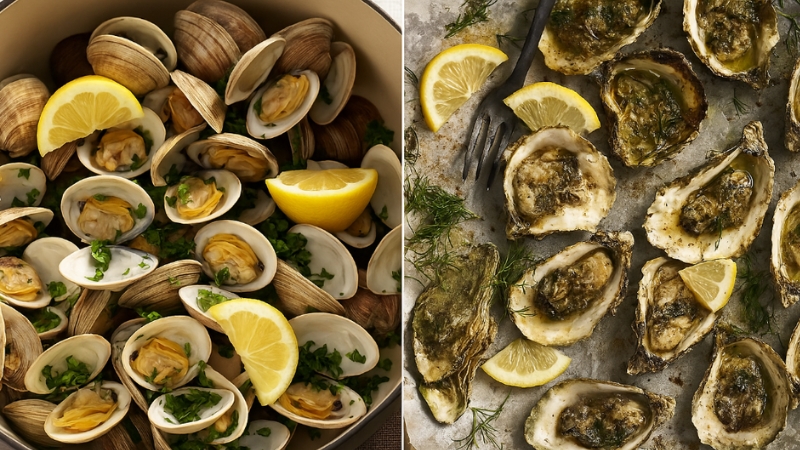I’ve had both oysters and clams fresh by the water and cooked in all kinds of meals that left the kitchen smelling like the ocean.
If you’re at the seafood counter trying to decide between the two, it really comes down to what you’re in the mood for.
Are you after something smooth and briny, or do you prefer something a bit chewier and more down-to-earth?
Oysters tend to feel fancier and more dramatic, while clams are more of a comforting, everyday kind of seafood.
Here’s a simple comparison—shell to shell—to help you figure out which one’s right for you.
That Weird, Wonderful Moment
@hatsbyabbey♬ original sound – Abbey
The first time I tried an oyster, I wasn’t sure what to expect. It looked weird, kind of slimy, and I wasn’t totally confident about how to eat it.
I went for it anyway. It was cold, salty, and the texture threw me off. But after a second, it made sense—it just tasted like the sea.
Didn’t love it right away, but it grew on me. Now it’s something I actually look forward to.
If you’ve ever tasted the rich, savory flavor of a king oyster mushroom sautéed with garlic and butter, you know what it means for a simple dish to elevate your palate.
Oysters are not for everyone, and they definitely aren’t your Tuesday night dinner staple.
Then There Were Clams
View this post on Instagram
Clams are more down-to-earth. No fuss, no show. You don’t need a special knife or someone explaining where they’re from.
They’re solid, tasty, and easy to cook a bunch of ways. I’ve steamed them with garlic and wine, thrown them in pasta, or grilled them for that smoky edge.
They’ve got some bite, a bit of salt, and just feel more like food—something satisfying. Oysters are more about the experience. Clams are just good eating.
Showdown: Oysters vs Clams
Let’s break this down. Here’s where things get interesting.
Feature
Oysters
Clams
Texture
Soft, slippery, almost gelatinous
Firm, chewy, with a bit of bite
Flavor
Briny, mineral-rich, subtle umami
Briny, slightly sweet, meatier, more robust
Appearance
Irregular shell, usually served raw on the half-shell
Smooth, symmetrical shells; often served cooked
Common Uses
Raw (half shell), grilled, Rockefeller, fried
Steamed, chowder, pasta, fried, stuffed
Raw Experience
Complex and oceanic—like wine from the sea
Less common raw, but when fresh, clean and sweet
Accessibility
Seen as a luxury, often pricey
More affordable and widely used in home cooking
Culinary Flexibility
Best raw or lightly cooked
Can be steamed, sautéed, baked, fried—you name it
The Real Difference on the Plate
Oysters are all about subtle flavors and a clean, briny taste. That first bite can catch you off guard—it’s salty, cold, and slippery, kind of like tasting the ocean itself.
But once you get past that, you start to notice the differences. Some are smooth and a little buttery, others have a hint of sweetness or a metallic edge. The flavors can be really layered if you’re paying attention.
Raw is where oysters really shine, but it’s also what makes them hard for some people to enjoy at first. The texture is soft and a bit unusual if you’re not used to it.
Still, once you get into them, they’re hard to stop thinking about. You start noticing which ones come from where, how they taste in different seasons. They’re not just something you eat—they’re something you come back to, again and again.
Clams are all about comfort and flavor. They’re not delicate or fancy—they’re bold, a little sweet, and full of that salty, meaty taste that makes them feel like real food.
They’ve got texture, too. You don’t just slurp them—you chew, you enjoy. Clams aren’t trying to be impressive. They’re just here to be good.
And they’re easy to cook with. Steam them in garlic, butter, and white wine, and the whole kitchen smells amazing. Toss them into pasta with some chili flakes and lemon, and they bring the perfect balance of salt and heat.
You can go simple, like chowder or grilled over coals, or stuff them with herbs and breadcrumbs for something more filling.
Clams show up and do the work. If oysters are something you try to impress someone, clams are what you actually want to eat.
So… Which One Deserves a Spot on Your Plate?

If you’re trying to impress someone, celebrate something special, or just want to treat yourself, go with oysters.
Serve them raw on ice with a little lemon, hot sauce, or mignonette. They feel fancy and a bit mysterious—definitely more about the vibe.
But if you’re looking to make something filling and comforting, clams are the better choice. They’re easier to cook, work with tons of flavors, and just feel more like real food.
Oysters are nice when you want a moment. Clams are what you make for dinner.
Final Word
So if you’re asking me which one deserves a spot on your plate? My answer is: Whichever one fits your mood.
But if I could only pick one to live with forever? It’s clams. Every time. Because I’d rather have something that feeds both the belly and the soul.
